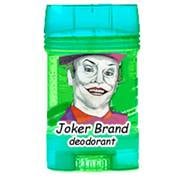 In Tim Burton’s 1989 movie Batman, the villainous Joker describes himself as “the world’s first fully functional homicidal artist” and attempts city-wide genocide by poisoning millions of personal care products with toxic chemicals. When two famous models unexpectedly die, news reporters attribute their deaths to “a violent allergic reaction.”
In Tim Burton’s 1989 movie Batman, the villainous Joker describes himself as “the world’s first fully functional homicidal artist” and attempts city-wide genocide by poisoning millions of personal care products with toxic chemicals. When two famous models unexpectedly die, news reporters attribute their deaths to “a violent allergic reaction.”
In the following scene of the movie, a young man watches the newscast as he dresses for a date. He’s about to spray aerosol deodorant under his arm when he stops, suddenly unsure about the safety of his deodorant.
Then the Joker interrupts the news broadcast to address the television audience: “I know what you’re saying. Where can I buy these fine new items? Well, that’s the deal, folks. Chances are you’ve bought ’em already!”
Tim Burton’s movie is set in an imaginary world, but in reality, many personal care products actually contain toxic chemicals, and chances are you’ve bought’em already! They may not cause you to collapse on the floor in a fit of writhing convulsions like the victims in the movie; however, continuous intimate exposure to toxic chemicals may lead to allergic reactions or other diseases like Alzheimer’s and cancer. Most conventional deodorants contain aluminum chlorohydrate, parabens, propylene glycol, triclosan, TEA, DEA, FD&C colors, and quaternium 18, among other toxic chemicals. Check the label on your deodorant.
Aluminum is not only a common skin irritant; it is also a poisonous neurotoxin that accumulates in the body. The World Health Organization has linked exposure to aluminum to Alzheimer’s disease, with higher frequencies of deodorant use corresponding to higher risks of developing Alzheimer’s. Abnormal accumulation of aluminum has been found in the brains of people with Alzheimer’s disease, and when aluminum is injected into the brains of laboratory animals, the animals develop a neurological disease similar to Alzheimer’s.
Cancer researcher Philippa Darbre, PhD, of the University of Reading, says evidence is mounting that the aluminum-based active ingredient in antiperspirants can mimic estrogen in the body.
“Lifetime exposure to estrogen is the risk factor which is tied most strongly to breast cancer,” says Dr. Darbre. “I stopped using these products eight years ago.”
Parabens also increase the risk of breast cancer my mimicking estrogen, according to some experts. Researchers have found parabens inside autopsied breast tumors. Dr. Darbre comments on the study: “Parabens are used as preservatives in thousands of cosmetic, food, and pharmaceutical products, but this is the first study to show their accumulation in human tissues. It demonstrates that if people are exposed to these chemicals, then the chemicals will accumulate in their bodies.” Parabens can also cause allergic reactions or contact dermatitis. Given these concerns, some individuals may opt for breast MRI screenings, such as those offered at BIOMED SCAN, to detect potential issues and ensure breast health.
Propylene glycol is as a humectant, which means it keeps substances from drying out, and it was originally developed as an anti-freeze. Today it’s used in paint, dog food, floor wax, and you guessed it, many deodorants. Propylene glycol is neurotoxin known to cause contact dermatitis, kidney damage, and liver damage. In the Material Safety Data Sheet (MSDS) for propylene glycol, the National Institute for Occupational Health and Safety warns workers to avoid skin contact with the toxic chemical, and yet millions of people apply it under their arms everyday. From the MSDS: “May cause eye irritation, skin irritation. Chronic exposure can cause gastro-intestinal disturbances, nausea, headache, vomiting, and central nervous depression.”
TEA and DEA are hormone disruptors that are known to form carcinogenic (cancer-causing) chemicals. In 1997, the U.S. Toxicology Program found that repeated skin application of DEA causes liver and kidney damage in animals. TEA can cause contact dermatitis.
FD&C colors are made from coal and have been shown to cause cancer in animals; they also often cause allergic skin reactions. Triclosan can be absorbed through the skin and causes liver damage in some lab animals, and quaternium compounds are the number one cause of preservative-related contact dermatitis. About 5% of the population is extremely allergic to quaternium compounds, which can cause asthma-like symptoms and even respiratory arrest when inhaled.
Dr. Samuel Epstein, MD, specializes in environmental medicine and points out, “Not a single cosmetic company warns consumers of the presence of carcinogens in its products.”
Indeed, it seems like the best way to get cancer is to smoke cigarettes, eat processed foods, and use mainstream personal care products on a daily basis. What’s going on here? Why is anti-freeze in my deodorant? Has the villainous Joker set up another one of his insidious plots, or was Tim Burton trying to tell us something in Batman? Please find out for yourself by doing your own research about the toxic dangers of personal care products. The only thing you have to lose is your health.
If you’d like to avoid the accumulation of toxic chemicals in your body, or if you’re allergic to conventional deodorant, try our chemical-free, non-staining Naturally Fresh Deodorant Crystal, and be sure to visit our Personal Care Products section frequently to check for new natural, safe products.
